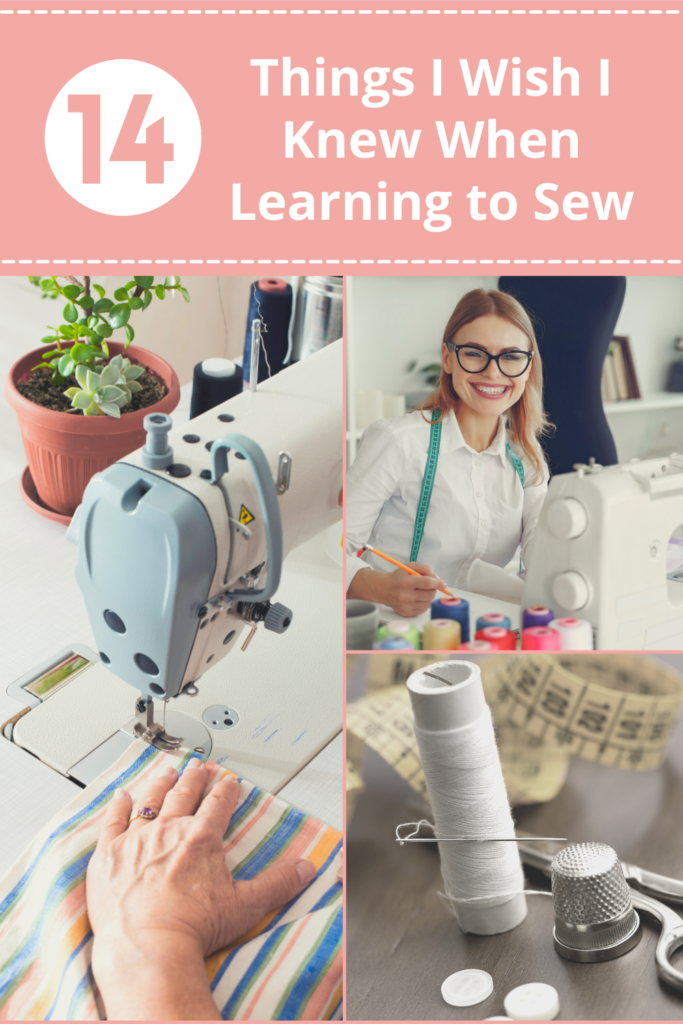Disclosure: This post may contain affiliate links. I earn a small commission when you click a link and make a purchase. Thanks for supporting SewingSociety.com!
Learning to sew is one of the best things I have ever done. I love being able to say, “I made that!” I thought it would be fun share some advice I’ve learned along the way to benefit people who want to learn how to sew, too. So, here are 14 things I wish I knew when learning to sew.
Contents
1. You Don’t Need an Expensive Sewing Machine
Did you know that some sewing machines cost over $15,000? I am not joking… I don’t think you should spend anywhere near that amount when you’re learning to sew. You don’t need a fancy sewing/embroidery machine combo when starting out. Wait to get one of those machines until you have proven you’ll actually use your machine and like to sew.
You can easily find a beginner sewing machine for under $300. If you don’t have a sewing machine yet, I suggest you read my post: What Is the Best Sewing Machine for Beginners? I outline three sewing machines that I think will set you up for success.
I personally own the Benette b79. It cost me around $2,000. I can’t imagine ever needing something better than this machine. If you have that kind of budget for a sewing machine, the b79 is AMAZING!
2. Sewing Subscription Boxes Can Introduce You to Tons of Sewing Tools
In addition to a sewing machine, you’ll need a basic sewing kit with scissors, tape measure, pins, etc. I also think it’s super helpful to get a sewing subscription box. I subscribe to Threadcrate (Get 10% off with code: Society10). They send me a pattern, fabric, and all the notions I need to complete a sewing project each month. I love how they also send me surprise sewing tools and goodies. I’ve discovered several new sewing products that I now love.
A sewing subscription box is a good idea for beginners because it takes the guesswork out of choosing fabric for a sewing project and figuring out all the tools and notions you need. If you’re interested, I’ve created a list of sewing subscription boxes that are available. Some focus on women’s sewing patterns and others are geared directly to beginners and those learning to sew.
3. Indie Patterns Are Easier to Follow than Commercial Patterns
If you are learning to sew, don’t just pick up a pattern at the fabric shop and expect to be able to sew it without a problem. Commercial sewing patterns use a lot of sewing jargon and terms that you need to learn. I suggest you start out with PDF patterns by indie designers. They have easier instructions to understand. As you learn more sewing skills, you can branch out into commercial patterns.
My favorite indie pattern company is Peek-A-Boo Pattern Shop. Their pattern instructions are extremely well written and each one has step-by-step, picture instructions. They are perfect for beginners looking to learn something new. Plus, Peek-A-Boo has a ton of different patterns for the whole family.
No matter what type of sewing pattern you decide to use, read all of the instructions before you begin. This way you’ll have a general idea of what steps to take and you’ll be able to get your questions resolved before you begin.
4. Your Sewing Machine Is Not Always Going to Cooperate
Your sewing machine is going to give you problems sooner or later. There are so many things that can go wrong, from breaking thread to messed up tension. This is frustrating to a beginner that doesn’t know what to do. When problems happen, try to stay calm. There are tons of resources to help you figure it out. If you’re interested, I created a sewing machine troubleshooting book you might find useful. You can keep it in your sewing room for easy reference when your sewing machine starts giving your trouble.
5. Slow Down. Sewing Is Not a Race.
Mistakes are more likely to happen when you’re trying to finish a sewing project quickly. When possible, try to avoid putting tight deadlines on your sewing projects. It’s better to take your time. Sewing becomes much less enjoyable when you’re in a hurry. You’ll speed up as you learn how to sew.
Read: 10 Super Easy Ways to Sew Faster
6. Preshrink Your Fabric Before Sewing with It
Cotton fabric shrinks when you wash and dry it. It’s better to take care of this process before you start sewing something with the fabric because the shrinking can distort your finished project. Washing your fabric also gets rid of excess dyes and chemicals that are used during manufacturing. If you’re not familiar with preshrinking, I suggest your read: What Everyone Ought to Know About Preshrinking Fabric.
You also need a good iron because you’re going to be using it a lot when sewing. Not only should you iron your fabric after washing it, but you should also press each piece of your sewing project as you go. I have a nice cordless iron, but I’ve heard good things about the Oliso Smart Iron.
7. Sewing Is a Dangerous Hobby. Be Careful!
Safety is something you should have in mind when you’re learning to sew. There are several ways you can get seriously injured while sewing. Most importantly, you need to keep your fingers away from the needle. People have sewn through their fingers and needed surgery as a result.
8. Let Your Sewing Machine Do the Work
Don’t pull on your fabric as you sew. The feed dogs under your presser foot were designed to feed your fabric through your sewing machine evenly for you. When you pull or push your fabric through your sewing machine, the seams can get puckered or you can break your needle.
If you’re sewing through multiple layers of fabric or your fabric is not feeding evenly, consider using a walking foot. It is helpful because it adds feed dogs on the top of your fabric.
9. Nobody Will Notice the Little Mistakes
Don’t be hard on yourself if your seams don’t look perfect. Most people won’t notice. As will all skills, practice makes perfect. The more you sew, the better you will get.
Buy an extra seam ripper. Your frustration will only grow if you can’t easily find it when you need to unpick a seam. I think it’s nice to have an extra seam ripper in your sewing kit. I’ve been sewing for a long time, but I still make a lot of mistakes. That’s just part of sewing… I keep a seam ripper next to my sewing machine and in my sewing kit.
10. Measure Twice, Cut Once
You should spend more time in the preparation stage than the sewing stage when working on a sewing project. Your sewing projects will turn out a lot better if you’re careful about pinning pieces together and cutting precisely. A good pair of scissors will save you time. Precise cutting is particularly imperative when working on quilts.
11. Only Work on One Project at a Time
I am guilty of starting one sewing project and then moving on before it is finished. This is usually because I neglected to buy everything I needed to finish the project. I then start something new while I wait for my supplies to arrive. This is not the best strategy. When possible, only work on one sewing project at a time. This way you don’t have to keep changing your thread and needle and rereading instructions. Gather all of the supplies you need before you begin. It will save you time in the long run. Plus, it prevents your sewing room from getting too disorganized
Additionally, try not to choose sewing patterns that are too far above your skill level. It’s better to learn one new sewing skill at a time so you don’t get frustrated and overwhelmed. For example, when you’re learning to sew you should start with something simple, like a tote bag, and then progressively choose projects that help you learn new skills: zippers, buttons, darts, etc.
12. Take a Sewing Class to Learn the Basics
If you want to learn how to sew, this is totally something you can teach yourself with a little determination. I think taking an in-person class is the best route, but videos will work. People always say that YouTube is your best friend when learning to sew. I’m sure you can find useful videos on there, but sometimes you don’t know what to search for. It’s hard to know what you need to learn. I suggest you take a beginner sewing class if you’ve never sewn before. There are a couple of good options on Craftsy. Once you have a good handle on setting up your sewing machine, sewing straight, and basic stitches, you can branch out on your own and follow sewing patterns.
13. Test Your Stitches on a Scrap Before Beginning a Project
One of the most challenging things to figure out when you’re learning to sew is what settings to use on your sewing machine for each type of fabric. Different types of fabric require different types of needles, and some require longer stitch lengths than others. Whenever you start a new sewing project, spend a few minutes testing your sewing machine settings by sewing some test stitches on a scrap piece of fabric. Then make adjustments until your stitches look the way you want.
14. Sewing Is Not Always Cheaper Than Buying Premade
People used to sew because they could not afford store-bought clothes. This is no longer the case. Fast fashion has made clothing yourself and your family much more affordable. However, that doesn’t mean that you can’t still save money by sewing your own clothes — you simply need to learn tricks on how to save money at the fabric store. The first thing is to only buy what you need for a project. If you buy extra fabric and notions, you’re just wasting money unless you have plans on how you’re going to use them.
Sometimes the advantage of sewing your own clothes isn’t about cost savings. People sew their own clothes to get the perfect fit and to create unique items. Sewing is also a creative outlet for many. I sew for a variety of reasons.
If you’re learning to sew, I hope you found the advice in this post helpful. If you have anything to add, please share it in the comments below.
Share this post on Pinterest!






I’m glad you mentioned not pulling or pushing the fabric through the sewing machine. My sister was telling me she wants to start sewing since she needs more hobbies while in quarantine. I’ll share this with her so she knows the basics and how to start sewing.